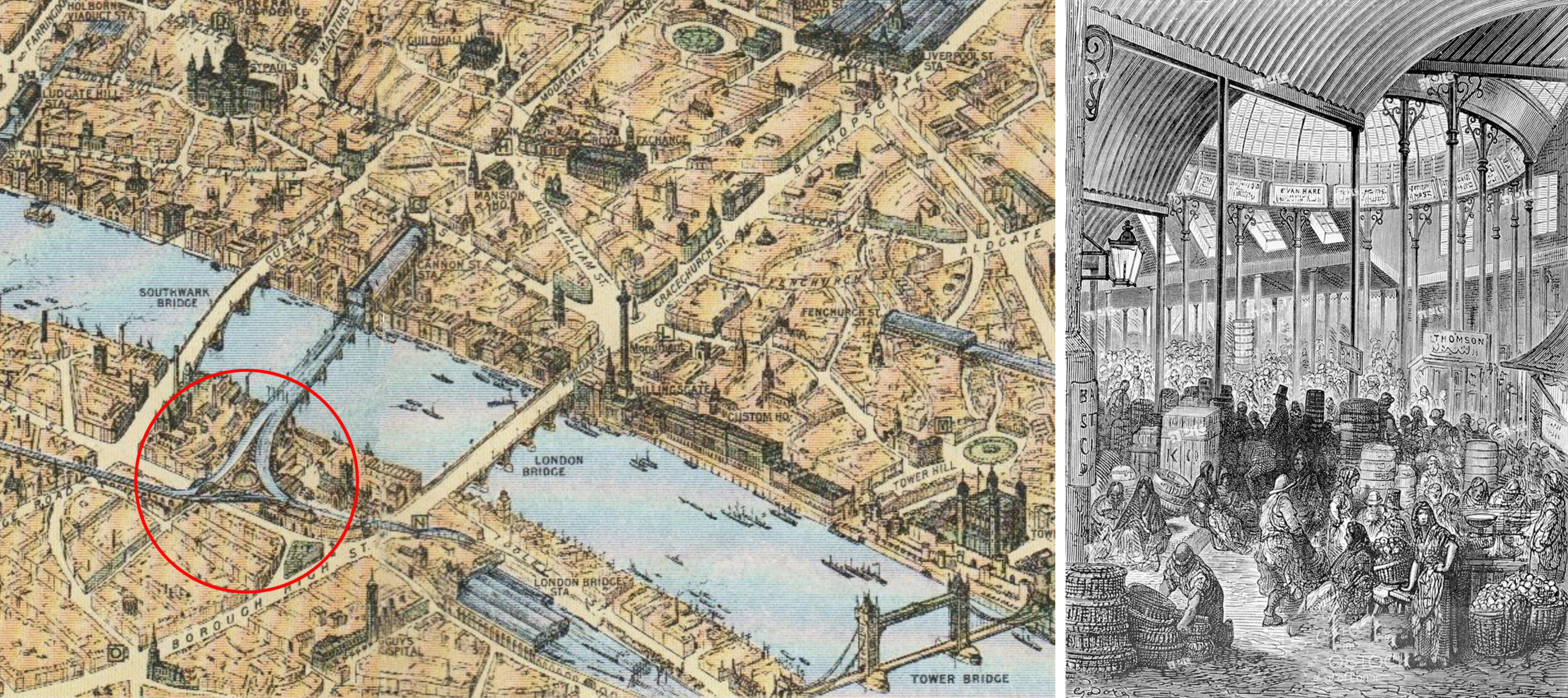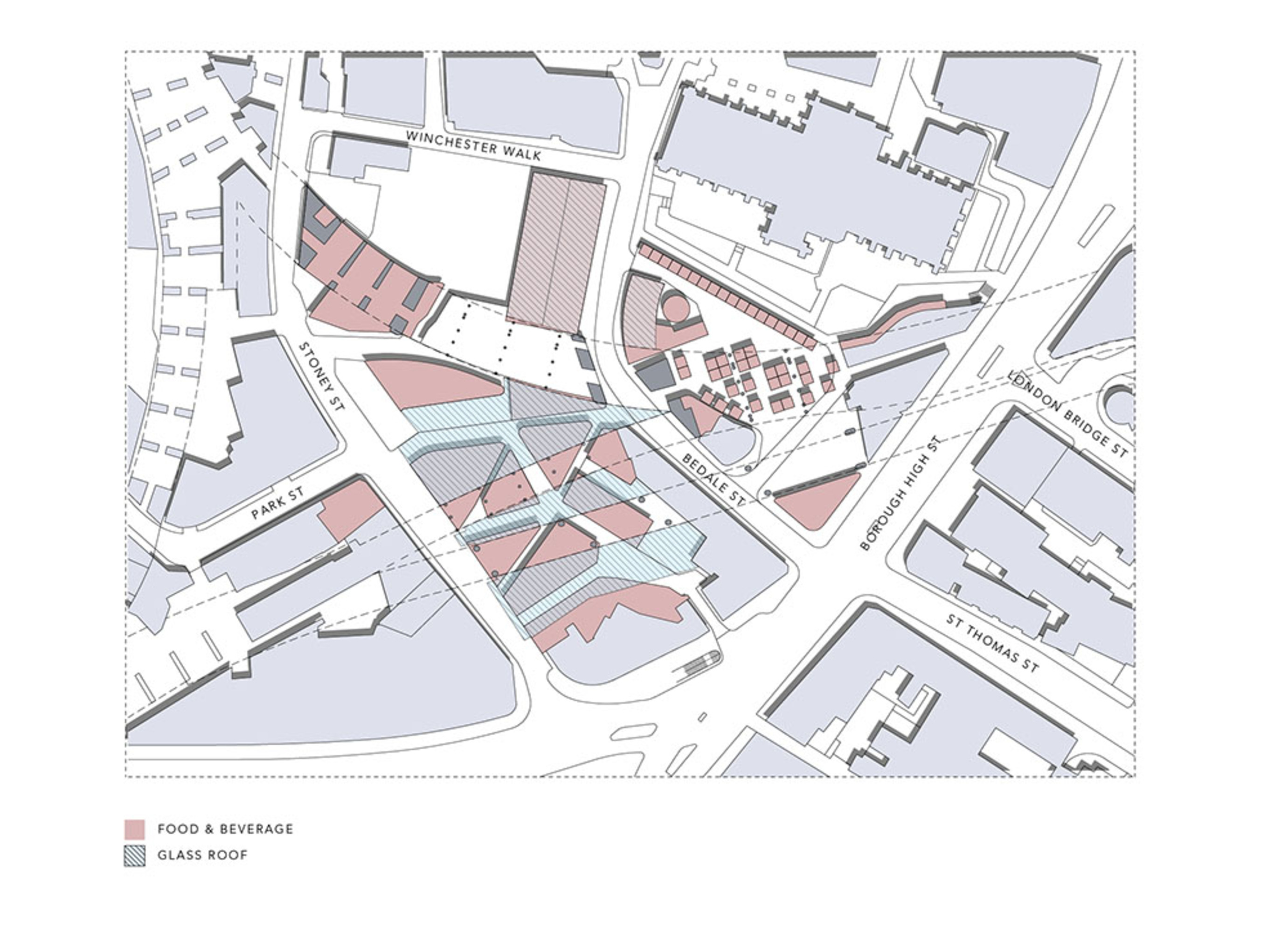
Borough Market is a must-visit destination in London. Located in a dramatic setting under three intersecting railway viaducts, Borough has become a showcase for artisanal food from all over England and beyond. The following description attempts to give some historical context to the market and is part of broader research into the markets of London, to be issued in a forthcoming Field Paoli guide.
A River Runs Through It — In Two Directions
Imagine that it's a few hundred years ago and you've just sailed a merchant ship across the English Channel to the Thames Estuary. It's low tide; furl your sails, and let the tide carry you upriver for the next six hours. As the tide turns, find a mooring so that you will not be carried back out to sea; you will have reached London. Ahead of you stands Old London Bridge. On the right bank, you'll see Billingsgate Fish market. Disembark on the left bank and you will be at Borough Market.
No other city in the world is blessed with a river that flows one way for six hours, then reverses course and flows the other way for the next six hours. Founded by the Romans at the beginning of the first millennium, Londinium was a natural staging point for commerce due to the tidal activity of the Thames. Julius Caesar and his invading army built the first pontoon bridge across the river. This was eventually replaced by the storied stone bridge, which for the next 1700 years remained the only permanent link connecting the two banks of the river. The Romans departed, but the bridge remained, with the City of London growing along the northern riverbank, and the Borough of Southwark (also known as "The Borough," or just "Borough") forming the bridge's southern gateway.
As London grew and thrived, so did its markets. The ebb and flow of the Thames continued to bring food and goods to satisfy London's ever-growing appetite, in exchange for exports of wool, cloth and manufactured goods. Covent Garden, Smithfield, Leadenhall, Stocks Market and Newgate Market were all bustling, noisy, smelly, dirty places of trade and exchange, all operating under the watchful eye of the City of London Corporation, which taxed goods as these were brought into the city. Given that avoidance of taxes is a compelling business motivator, it was inevitable that opportunistic markets would occur outside the city gates, and so around the end of the first millennium, Borough Market came into being just beyond the southern end of London Bridge.

The tides of the Thames created the greatest commercial city in the world. For over 1700 years London Bridge was the only river crossing, and at the foot of the bridge, beyond the reach of the City's taxes, stood Borough Market.
A Riotous Retail and Entertainment District
The market certainly had location, location, location going for it: everyone entering London from the rich agricultural South had to funnel through Borough High Street on their way to London bridge. And so the neighborhood grew around trade and transit, with inns serving travelers and the market allowing farmers to sell their goods without having to pay duties and taxes to the City. Over the next 1,000 years, Borough Market was to grow and evolve, reflecting changes in the distribution of food and consumer tastes, morphing from a retail market to a wholesale market to a specialty food market, and displaying a unique resilience along the way.
In its early days the market had a distinct anti-authoritarian bent, and the adjoining neighborhood soon gathered a reputation as a lowbrow retail and entertainment district. The yearly Southwark Fair was a riotous, not-to-be-forgotten experience, and Borough attracted a colorful cast of characters and an equally colorful cast of neighbors: bear-baiting pits, houses of ill repute, prisons and above all that subversive form of public entertainment known as the theater. When a young playwright by the name of William Shakespeare looked for a place to build a new theater for his company, Southwark was a natural fit, and it became the home of the now famous Globe Theater.
The market's success was resented by the City, and after initially making it illegal for Londoners to shop there, the City ended up purchasing the whole neighborhood in 1550 for the princely sum of 1,000 pounds. By that time, the market was firmly entrenched at the north end of Borough High Street, creating severe congestion that only worsened when the Great Fire of 1666 wiped out most of the city markets, leaving Borough unscathed. Eventually in the 1750's the market was forced to relocate a few hundred feet west, near the intersection of the evocatively named Foul Lane and Dirty Lane, where it continued to sell a large range of everyday produce.
The Industrial Revolution and the Rise of the Railroads
The momentous changes created by the industrial revolution had a huge impact on London's markets. London began building its great railway stations: King's Cross, St Pancras north of the River, and London Bridge and Waterloo Stations on the South Banks. The railroads resulted in profound changes in the way food was supplied to the capital. Bringing Scottish cattle to market in London used to take almost two months; now it took two days. The huge growth of London's populations, coupled with the influx of goods brought by the railroads, created a new type of market: the wholesale market. The proximity of London Bridge station, the new gateway to Southeast England, turned Borough into an important fruit and vegetable wholesale market.

The railways of the Industrial Revolution transformed Borough Market into a wholesaling powerhouse. The railway companies spanned three viaducts over the market, and in exchange agreed to roof the market with a striking glass dome, demolished in the thirties after an additional railway expansion.
The railroads had
another impact on the market: new railway bridges were built across the Thames
to link London Bridge station to Cannon Street, Charing Cross and
Blackfriars railway stations. The only problem: Borough Market was in the
way. New viaducts were built over the market; in exchange the railway company
built a striking glass domed roof for the market. Borough continued
to be busy: at its peak, the wholesale market was a place of furious
activity, supplying millions of people in London and the southeast. Hundreds of
porters were employed directly by the market to carry produce to and from the
many stalls, with trading taking place all through the night, and continuing
into the following day. At the end of their shift, in the early morning
hours, porters retreated to the adjacent Market Porter Pub, which gained a
special license to serve beer starting at 7 in the morning. To this day,
the Market Porter is one of the only pubs in London where you can get a pint
before 11 am.

In addition to the railroads, the Victorian era saw a rapid expansion in the number of pubs in London. Thankfully after a hard night's work in the market, porters could get some rest, relaxation and a pint of beer at the adjacent Market Porter Pub, still open for business today.
Decline and Rebirth
Borough Market’s days as a vital wholesale hub were ended in part by the construction of New Covent Garden market in nearby Vauxhall in the 1970s, but also by the arrival of a new type of retail building: the supermarket. These slowly killed off independent greengrocers and destroyed the distribution system in which fruit and vegetable wholesaling had thrived. The market slowly declined, until the market's trustees had the bright idea in the 90's of inviting British locavore pioneer Henrietta Green to curate a farmer's market featuring 50 of the best food producers in England. The event took place in November of 1998; over 30,000 people showed up, and thus began the next phase in the evolution of Borough.

Ever since the late nineties Borough has been at the vanguard of the foodie revolution, and features organic food products from England and beyond.

Borough has become a favorite destination for the lunchtime crowd, attracting a mix of office workers, residents and tourists.
A monthly retail market was set up; monthly turned to weekly, weekly turned to daily: today Borough is perhaps the most famous food market in England. It is now open six days a week (it's closed on Sundays), and continues to be a favored destination for locals, office workers and tourists. The market features a range of organic produce; fish, seafood, meats, cheeses and preserves from England and beyond; freshly baked artisanal breads, olive oils, teas, coffees, wines, spirits, spices; the list goes on, not to mention the huge variety of lunchtime prepared foods. Many of the traders who started the market’s regeneration in the nineties are still here. The market is run by a Board of Voluntary Trustees with local connections, and any surplus is passed to the London Borough of Southwark for the benefit of the residents of St Saviour’s Parish.
According to market
manager Darren Henegan, over 15 million people a year visit Borough, which
speaks both to its tremendous success and to the amazing culinary evolution/revolution
that has occurred in England over the past two decades.

Borough’s unique atmosphere is a mix of Piranesi, distribution warehouse, farmer’s market, market hall and Victorian Railway Station.
A Recipe for Success
Borough continues to reinforce the extraordinary power of food to create world-renowned destinations. Some key ingredients of Borough's success include:
- A unique setting that celebrates the layers of evolutionary change that led to the market's present incarnation;
- Dramatic architectural elements, with lightweight glass roofs juxtaposed against the heavy railway viaducts;
- A complex layout that invites wandering and losing oneself;
- A powerful sequence of spaces of differing scales;
- A loose organization of vendors, with prepared foods along the northern boundary of the project, rotating vendors in the middle and more permanent vendors in the south west quadrant;
- An overlay of events including tours, cookery classes, and education about food.
Let's hope Borough keeps going for another 1,000 years!
